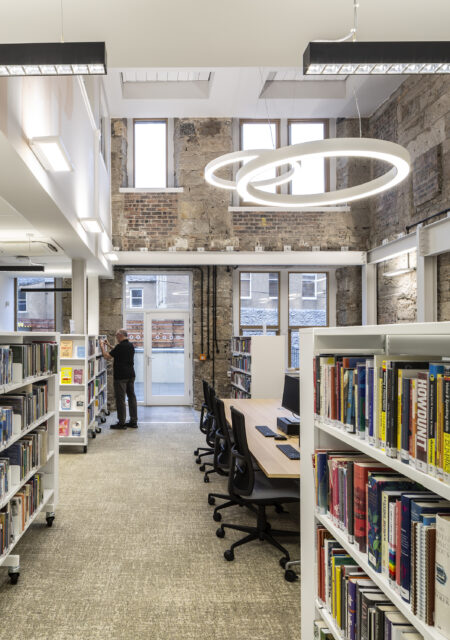Paisley Central Library
Category
Regeneration
Company
Collective Architecture
Hub West Scotland, CCG (Scotland), Tuv Sud, Armour Construction Consultants, New Acoustics, Claire Barclay, JGA Fire Engineeers
Client
Renfrewshire Council
Summary
Renfrewshire Council’s brief for Paisley Central Library was to create a dynamic, community focussed, new Central Library set within a dilapidated and constrained historic building at 22 High Street, Paisley. As with many high streets showing signs of decline and reduced footfall Renfrewshire Council have a focus on regenerating Paisley town Centre with significant works being undertaken on other facilities such as the Arts Centre, Town Hall and Museum. Hub West Scotland were appointed as the delivery partner for the Council and assembled the design team, led by Collective Architecture and the contractor CCG for delivery of the project. Work began on this exciting project in 2018. This commission built on an earlier feasibility study in 2016 that considered four potential sites before recommending 22 High Street as having the most potential to impact the regeneration of the town centre.
This facility accommodates the library service previously located at Paisley Museum, where the vacated space now forms part of a major redevelopment to transform Paisley Museum into a world-class visitor destination. This project and the new Library are central to the Council’s strategic investment in cultural infrastructure within the town centre, intended to transform a declining High Street context into a vibrant cultural neighbourhood.
22 High Street is part of Paisley’s medieval centre, previously the site of the Semple Family’s town house which dates from the 17th century. The current building was constructed in 1876 and substantially modified in the 1950s. This location offered several challenges and opportunities. Being close to several other important civic buildings and having excellent public transport links, the High Street location allowed for the design of a truly ‘public’ library which was open and welcoming to all. However, the building also presented some significant refurbishment issues including demolition within a constrained environment, removing extensive amounts of asbestos, upgrading the remaining structure to take library loadings, and installing new structure to increase the floor area by introducing mezzanine levels.
Externally, the design aimed to ensure differentiation from the adjacent commercial units, and to signify this building as a destination. The re-design of the two storey ‘shop frontage’ strives to be distinct and iconic. This is achieved by a grid of sculptural, bent metal fins that sit in front of the curtain wall glazing system and have a folded form to echo the bending of a piece of paper to make an origami form or mark the place in a book. The façade is visually open and allows passers-by to look into the library, with the hope that the space and services provided by the library become an extension of the public high street.
Internally, the complex building alterations create a welcoming, varied, and light interior environment which provides a series of linked urban rooms within the constraints of the existing footprint. An urban foyer accessed from the High Street leads to secret rooms in the Children’s library that encourage play and exploration. A living room on the first floor houses the main library collection and leads to events rooms for meetings and performances. The second floor reading room provides a quiet environment and leads to an outdoor room providing an external, elevated courtyard and the study room gallery in the floor above.
In additional to the extensive lending book stock, the building provides a Community/Events Room and excellent IT facilities, including Wi-Fi and charging points to all areas, a dedicated IT room and numerous workbenches, tables, desks, and nooks, distributed throughout, providing a range of spaces to access the PCs provided or to set up personal laptops.
To ensure a consistent design approach throughout the building, the Architect’s commission has been extended to include the design of bespoke fixed furniture, including the Children’s Library play structure and the specification of loose furniture.
To add an extra layer of visual interest, collaboration with artist Claire Barclay and Collective Architecture successfully created a co-design of the children’s library play structures and feature wall paintings.







